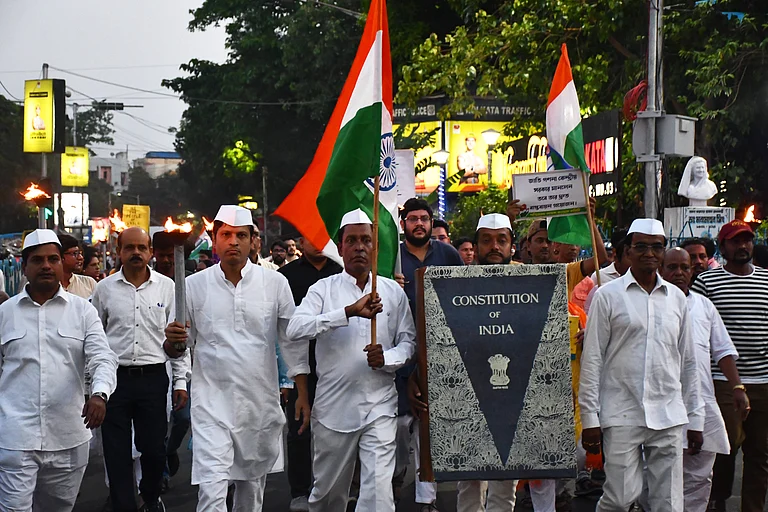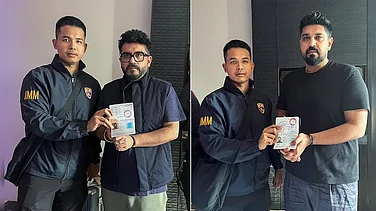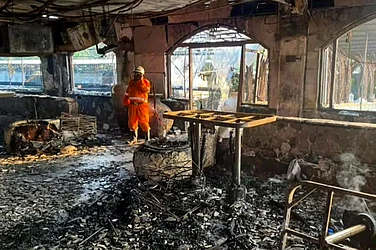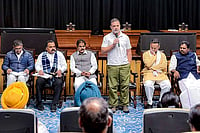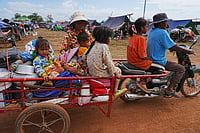
Though women aren’t part of RSS shakhas or uniformed events, the organisation claims this exclusion is practical, not ideological, citing outdoor, physical shakhas as unsuitable for women.
RSS upholds the idea of men and women as complementary forces, emphasising women’s nurturing and maternal roles as vital for family, society, and national development.
In 1935, inspired by Hedgewar’s encouragement, Laxmibai “Mavshi” Kelkar founded the Rashtra Sevika Samiti to enable women’s participation and leadership within the RSS ideological framework.
With the motto “Sarva Mangal Hetave”—for the welfare of the entire world—the Rashtriya Swayamsevak Sangh (RSS) was founded with the goal of making this nation supremely glorious. This year, on Vijayadashami, it completed a century. The journey of the RSS has passed through phases of neglect, opposition, struggle and favourable times, and today, it has evolved into the world’s largest voluntary organisation. Its work is discussed through various aspects; one key aspect being—women and the RSS.
You don’t see any women in RSS shakhas or in uniformed events, like the significant marches. So, a prominent question that is asked is—why aren’t there women in the RSS? While this question never bothers women associated with the RSS, or those active in the organisation’s ideological world, but it is a fair question to ask, nevertheless.
Since women aren’t visible in shakhas, it might create confusion about RSS’ perspective on women. K.B. Hedgewar, the founder, had clearly stated before establishing the RSS that the aim was to organise the entire society flawlessly in every aspect. So, including women was only natural and obvious. It’s just that the circumstances back then were widely different. Also, because RSS shakhas are primarily physical and are held outdoors, women aren’t a part of them. But that doesn’t mean the RSS wants to organise a society without women, or that it’s anti-women, or that women aren’t involved in RSS’ work at all. In fact, whether women get a place in the shakhas or not isn’t a theoretical issue; it’s purely practical.
Drawing from his experiences in social and political fields, Hedgewar, fondly known as Doctor ji, started RSS’ work single-handedly with just 15-16 young men. Initially, the focus was on expanding the shakhas. From there, ideas for various mass organisations, activities, and institutions emerged, and through them, swayamsevaks (volunteers) began organising society. At the time of its founding, shakhas were the only medium. Today, there are 32 all-India level organisations, and hundreds of smaller ones inspired by the RSS thought, all started based on needs. In the same way, work among women also began.
Here, it is important to recall the philosophical view in Indian life and in the RSS: Indian thought sees the entire existence as integral and one. This oneness means that even though things appear different, everything is interconnected, interrelated, and interdependent. So, people aren’t just individuals; their expanded form is the family, then society, the nation, and even the universe. In other words, humans are an inseparable part of the universe, nation, society, and family. The RSS believes, just like men, women’s active participation is essential for society’s progress, sustainable development, family nurturing, societal sustenance and national revival.
Since the entire existence is integral, there’s no competition or opposition—only affection and mutual complementarity. However, recognising the special qualities of women and men, their complementary participation is expected in every field. Because of her unique qualities, a woman can become a mother, nurturing the child in her womb. She lays the foundation of children’s lives through prenatal and postnatal education, and so, without losing her maternal qualities, her involvement in social and national work must increase—this aligns with Indian life philosophy and is deeply held in RSS’ ideological world. From this complementary role, while shakhas for men started early, Doctor ji encouraged and supported the creation of a women’s organisation that considered women’s needs and expectations, when the need and significance of women’s participation surfaced.
The RSS believes, just like men, women’s active participation is essential for society’s progress.
“Why no entry for women in Sangh shakhas?”—with this very question, the founder of Rashtra Sevika Samiti, Laxmibai, alias Mavshi Kelkar, met Doctor ji around 1935. She was deeply worried about women’s safety. She had seen qualitative changes in her sons who attended the shakhas, and she was convinced this was the right path for women’s all-round development. Doctor ji welcomed Laxmibai’s thoughts but encouraged her to take the lead herself— considering women’s lives, awakening among them, and their roles at every level—to start women’s shakhas and organisation. He assured her full cooperation.
The goal of building a supremely prosperous nation—with shakhas as the method and Hindutva as the foundation—became the guiding principles for both organisations. Not just that, Doctor ji personally ensured that the English initials for the RSS and Rashtra Sevika Samiti would be similar, creating a common identity. Inspired by discussions with Doctor ji, Kelkar boldly founded the Rashtra Sevika Samiti on Vijayadashami in 1936. Doctor ji adopted a broad view that women’s work should grow independently yet with mutual cooperation under the same ideology.
As a result, women embracing the RSS thought began focusing on women’s development independently. From making young women self-reliant in self-defence, to shaping their roles in individual, family, society and the nation—they took charge, with RSS’ support, when needed. Based on Indian life ideals, women’s participation in the RSS work grew through mutual complementarity.
History tells us that women, while fulfilling family roles perfectly, started joining national work. Doctor ji and the RSS volunteers gave them full encouragement and support. To understand methods and principles, Kelkar stayed in RSS camps. Doctor ji personally ensured initial classes and meetings were set up well. Indutai Bhave, from the Samiti’s first shakha, once told me: “Doctor ji wanted girls to struggle themselves, become self-reliant through effort. He never took a controlling or guiding role; he was a master sculptor, shaping people.”
While travelling for RSS’ work, he would inform local women about Samiti work and encourage them to start it. Notably, influenced by the RSS’ work, swayamsevaks’ household conduct, and the need, women in many places, like Pune, Hyderabad and Solapur, started work under names like Rashtriya Swayamsevika Sangh or Hindu Dharma Bhagini Mandal. Doctor ji took the initiative to unify all these under one thread. Similar to the RSS, women’s shakhas came together under Kelkar’s leadership to expand Samiti work.
To understand what the RSS founder felt about women’s work, here’s an excerpt from his intellectual session with Samiti sevikas on June 24, 1938: “The Samiti was established for the all-round upliftment of the nation. It must plan so that the Hindu nation rises to excellence without slipping. The work is tough, but that’s where the beauty and valour lie.” (Reference: Stri Shakti Ka Sakshatkar, Deepojyoti Namostute)
Founder’s Encouragement
The role, encouragement and efforts by the RSS founder for women’s all-round upliftment have remained consistent in the Sangh’s long journey. Both Sangh and Samiti started in the pre-independence era. This long path has been walked with complementarity and cooperation. Be it the Partition, the dark Emergency period, or the Ram Janmabhoomi movement—in all national or local events, the cooperative role stands out. The Samiti has 4,500 shakhas across the country, 64 establishments, and 1,700 service projects, through which society awakening, organisation and service continue.
The second sarsanghchalak, Shri Golwalkar Guruji, expressed his view on women: “We must not let any feeling of helplessness or inferiority creep into our mothers and sisters for any reason. We must teach them they are living embodiments of supreme power. Today, women do heavy physical labour, some utterly destitute—seeing this should fill our hearts with deep sympathy. We must plan to provide them with jobs and livelihoods. It’s our sacred duty to ensure no sister or mother lives a neglected life on the streets, sparing no effort.”
The role, encouragement and efforts by the RSS founder for women’s all-round upliftment have remained consistent in the Sangh’s long journey.
In Guruji’s time, from Sangh’s ideological meetings, organisations like Akhil Bharatiya Vidyarthi Parishad, Bharatiya Jan Sangh, Bharatiya Mazdoor Sangh, Vanvasi Kalyan Ashram and Kisan Sangh began. In each, women’s notable participation was there from the start. From carrying mats to owning the stage, women played every role enthusiastically. Later, many more activities and organisations emerged from the Sangh’s thought. Women’s substantial involvement is in all. Parivar Prabodhan, Samajik Samrasata Manch, Gram Suraksha—these are just examples. In all such institutions and organisations, women play active roles.
Thousands of pracharikas and full-time workers dedicate their lives to national work; homemakers prioritise “national duty”—all fulfilling their responsibilities. In ability, service, sacrifice, leadership and management, women have shown they’re not behind by an inch, time and again. Even in recent Covid times, sevikas in Bhuj performed last rites in crematoriums; in natural disasters, they went all out for food, clothes, shelter; donating from jewellery to land; or diving into education, service, environment, women’s safety—hundreds of RSS-inspired women have set ideals in society. They work in urban, rural, hilly, tribal, remote areas, from diverse social, economic, educational backgrounds. Their work is voluntary and service-oriented—no need to mention again. The organisation’s service works are a proud part of its journey. Projects for society’s upliftment are run, with over half focusing on women’s empowerment— through employment, health and education. Overall, in the RSS’ policy context, note the resolution on women from the representatives’ meeting at Vrindavan. It called for striving to end women’s backwardness and give them dignity.
In 2017, Sangh-inspired women workers surveyed around 75,000 women from all strata—from ascetics to big entrepreneurs—to understand their status, especially in health, jobs and education. This voluntary effort might be the first of its kind. In women’s empowerment, both men and women workers complement each other ideally.
Many young women are inspired to learn the organisation’s work, contribute, and become workers. On the official RSS website, the “Join RSS” window saw 23,272 women express interest from 2017 to 2021. Between 2021 and 2025, it doubled. Not just this medium—through direct contact, many young women and ladies voluntarily join and are integrated into various work areas. To gauge women’s response to RSS’ thought and work, the 2023-24 Matru Sammelans’ (mother’s gathering) figures speak volumes. Sangh-inspired women organised 472 conventions nationwide, with over six lakh women participating massively. In many places, women led, and volunteers supported them, when needed.
Last year, from May 30, 2024 to May 30, 2025, mainly RSS-inspired workers organised 67,000 diverse events for Lokmata Ahilyabai Holkar’s tricentennial. Women participated equally with men; in many spots, they led yatras, rallies, conferences, tree planting, temple and river cleanings. This year-long celebration was a unique, spontaneous example of independent yet collaborative work.
I haven’t even mentioned family-level cooperation. Thousands of volunteers and pracharaks’ family and their social involvement reach fruition only with mothers’ support at home. The same for women. Due to this mutual companionship, in a recent lecture series at Vigyan Bhavan, current sarsanghchalak Mohanji Bhagwat said on the third day: “For every volunteer, there’s at least an equal maternal power in the RSS!” Overall, looking at the RSS’ journey and its stance on women, it’s clear the RSS actively participates in all-round upliftment for everyone, including women, and women are embracing the RSS thought in life, joining its work—this is consistently evident.
As described in an RSS song: “Let’s all pull India’s great chariot together, with speed in feet, strength in hands, devotion in hearts.” With men and women’s participation, that chariot will march to victory, and India’s Sun of valour will shine brightly at full speed.
May that golden day come soon—this is my prayer to Shri Shakti!
(Translated by Kajal Boraste)
MORE FROM THIS ISSUE
Sunila Sovani is a journalist, writer and All-India publicity chief, Rashtra Sevika Samiti








